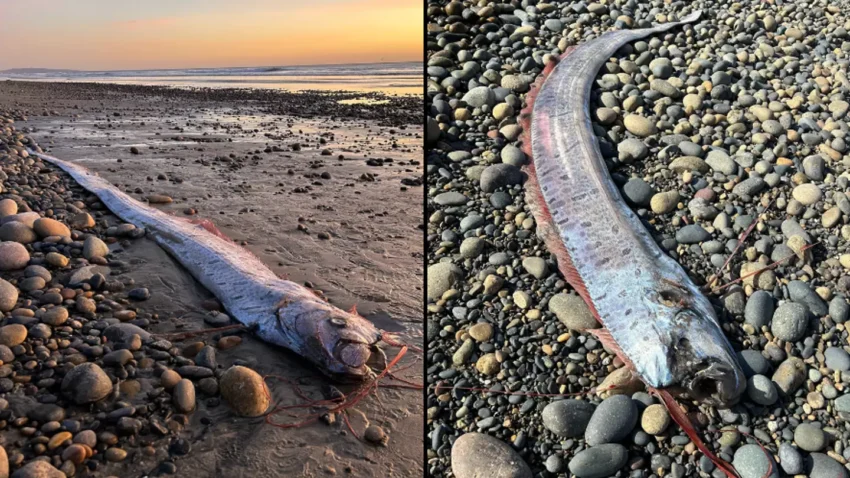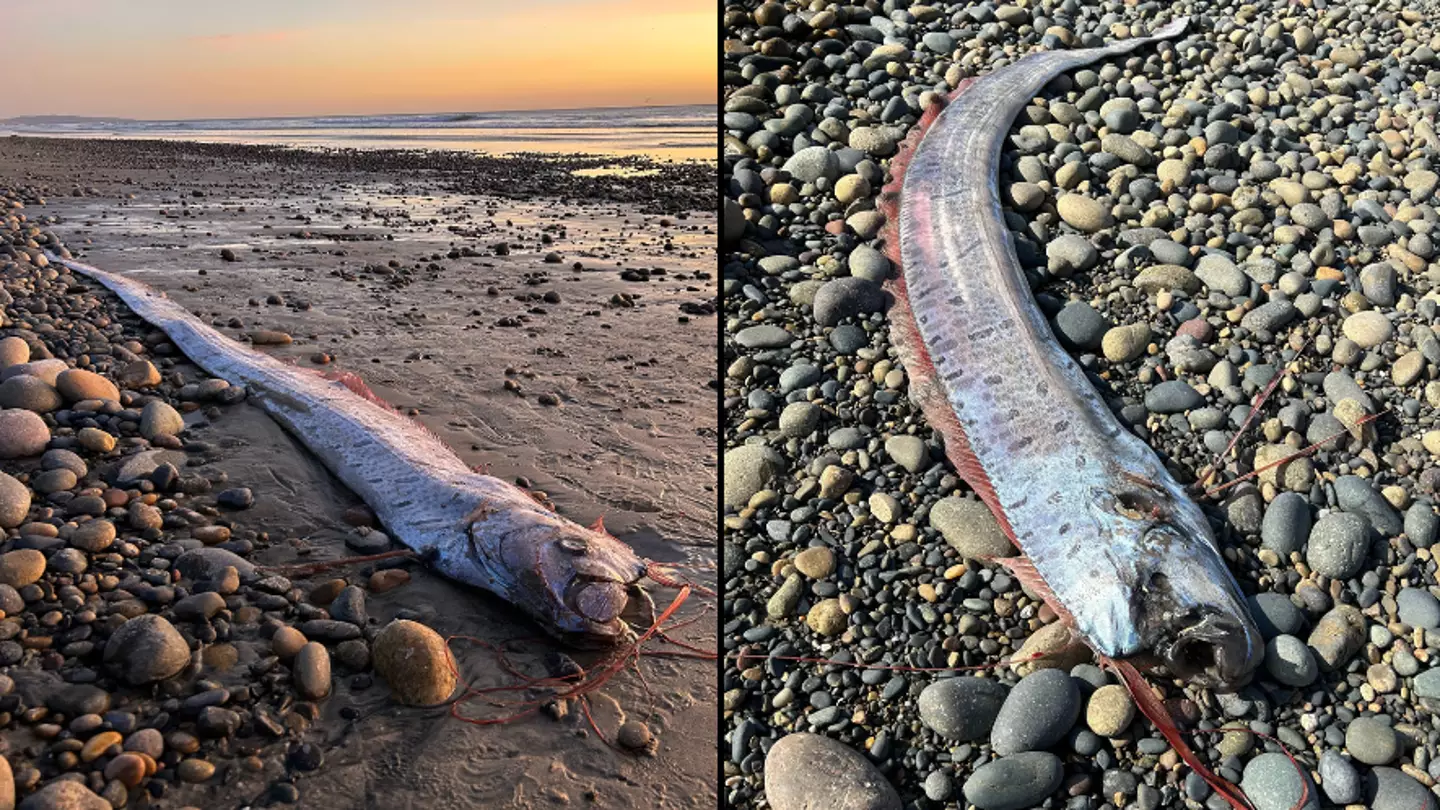
For the second time in 2024, a rarely seen deep sea fish, known as an oarfish, has washed up on the coastline in California.
The creatures are historically considered a ‘harbinger of doom’ and tend to live in an area of the deep sea called the mesopelagic zone, where light cannot reach.
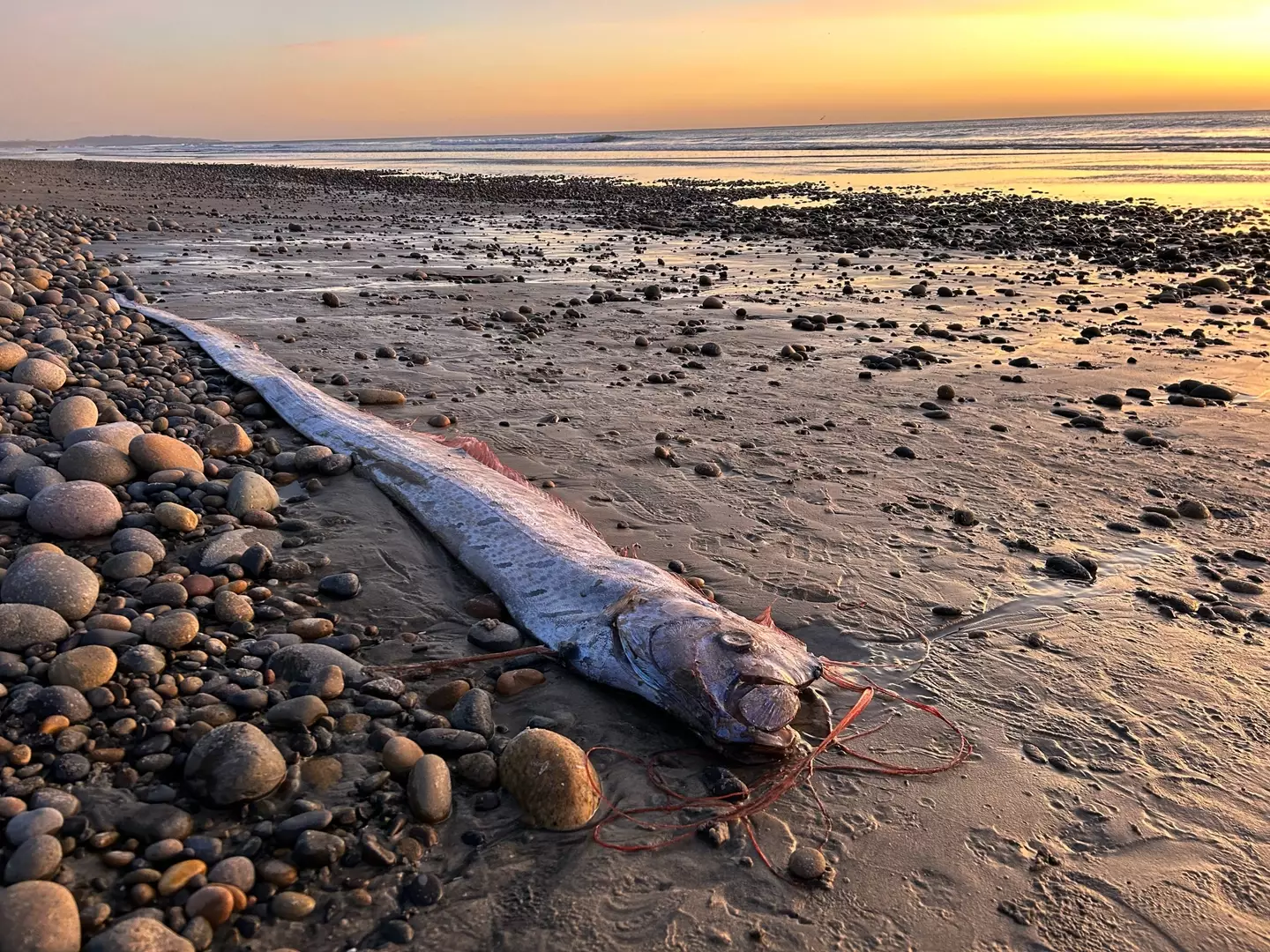
The 10ft-long specimen was discovered on Encinitas beach. (Alison Laferriere/Scripps Institution of Oceanography)
The Scripps Institution of Oceanography at the University of California, San Diego, reported that, last week, one of its PhD students came across a specimen on a beach in Encinitas, southern California, and it measured roughly around 10ft long.
Oarfish tend to have long, ribbon-like bodies and are often referred to as ‘doomsday fish’.
Scripps Institution of Oceanography shared on X: “Look what decided to make another appearance! Last week, another #oarfish washed up on Grandview Beach in Encinitas and was spotted by Scripps Oceanography PhD candidate Alison Laferriere. This cool creature measures roughly 9 to 10 feet long.”
In a second tweet, the account revealed what Scripps’ Marine Vertebrate Collection Manager Ben thinks, adding: “Like with the previous oarfish, this specimen and the samples taken from it will be able to tell us much about the biology, anatomy, genomics and life history of oarfishes.”
Social media users were shocked at the photographs of the 10-ft specimen.
One person said: “They look amazing! Wow! This will help scientists understand these creatures better and also look for reasons why they’re appearing more frequently on our beaches,” while a second added: “Magical fish!”
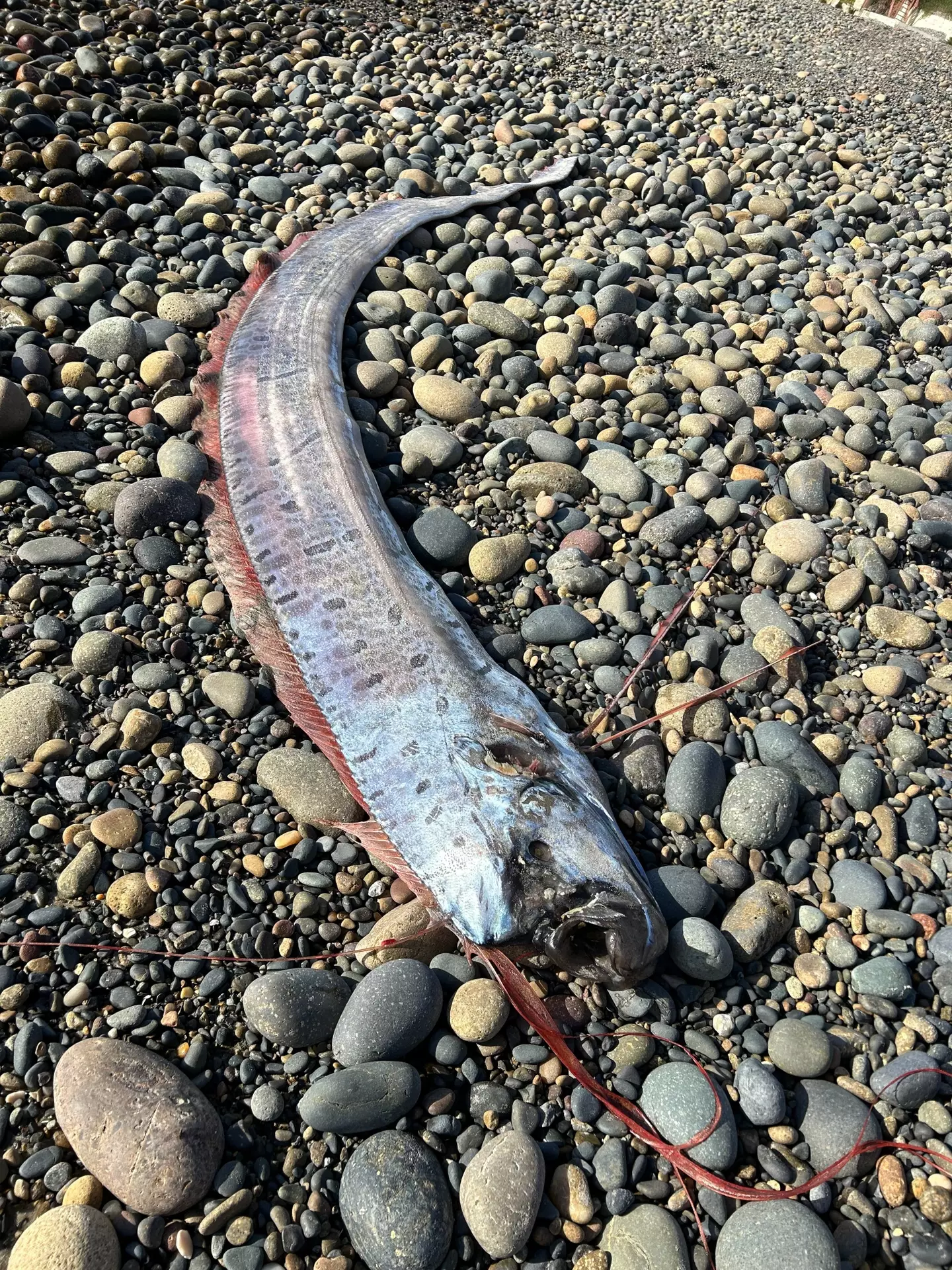
It’s the second time an oarfish has washed up on the California coast this year. (Alison Laferriere/Scripps Institution of Oceanography)
The creatures got their nickname due to their mythical reputation as predictors of natural disasters or earthquakes. In the months leading up to the 2011 earthquake in Japan, 20 oarfish were found on beaches around the country.
The latest discovery comes just a number of months after a group of kayakers and snorkelers came across a 12ft-long oarfish off the San Diego coast, floating dead in the water.
Seeing these creatures wash up on the shore is a very unusual occurrence, with oarfish having only been documented washing up in California on 20 occasions since 1901, per The Guardian.
Researchers took samples and froze the oarfish recovered recently for further study. Preservation is planned in the institution’s marine vertebrate collection.
The discoveries this year have allowed scientists to conduct in-depth studies on oarfish, enabling them to analyse the creatures’ organs and bodies.
Featured Image Credit: Alison Laferriere/Scripps Institution of Oceanography
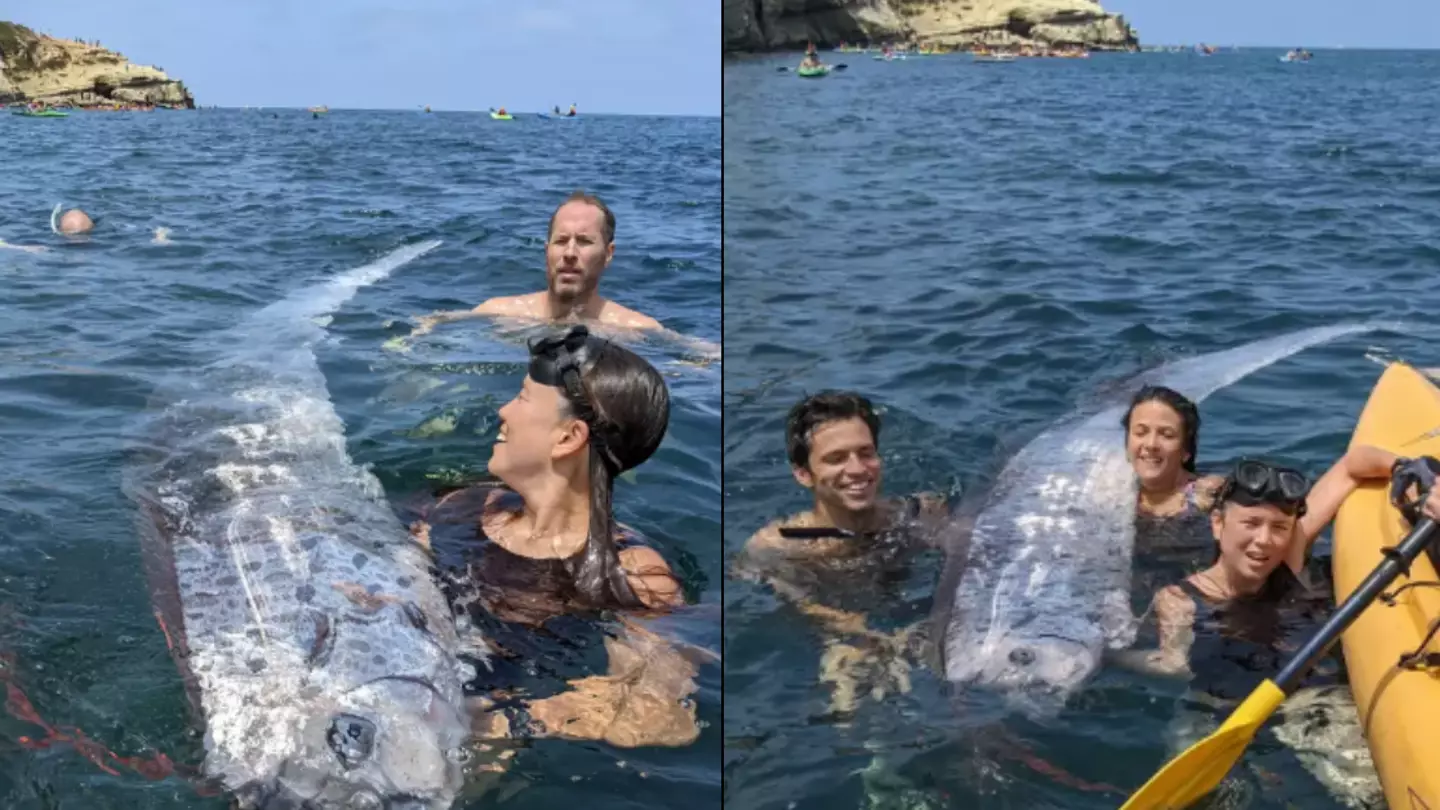
Yeah, I know, that sounds like the opening to some mad sci-fi film or a creepy new Netflix show – but it actually seems to be a real life ‘sign of pending disaster’.
Oh, and this mysterious creature was dead when it was found. Not quite the happy Friday news you might have been hoping for.
The absolute whopper known as the ‘harbinger of doom’ was found off the coast of California last weekend by kayakers and snorkelers exploring San Diego’s La Jolla Cove.
At a mega 12-foot, the oarfish is believed to be the sign of impending earthquakes. And, well, the washing up carcass delivered on its promise – whether it was wanted or not.

Now that’s a bad omen. (Scripps Institution of Oceanography/Facebook)
Just two days after the group found the ‘doomsday’ fish, a 4.6 earthquake shook Los Angeles.
They weren’t exactly bothered by the discovery in the waters though as they cuddled up to the carcass for some snaps.
After getting those pics though, the group did report their eerie finding to UC San Diego’s Scripps Institution of Oceanography, where officials are performing a necropsy to determine what killed the young oarfish and led to its body showing up in shallow waters.
SHOCKING TWIST IN MYSTERY OF ‘IMMORTAL’ SHARKS
CANINE EXPERT’S SURPRISING ANSWER ON MOST ‘DANGEROUS’ BREED
It’s a particularly odd discovery because not only are the creatures deep-sea dwellers but they are rarely seen by humans.
Plus, even when they are dead, it’s rare that they’d end up in shallow areas like this.
The centre said only 20 oarfish have washed up in the entire state since 1901.
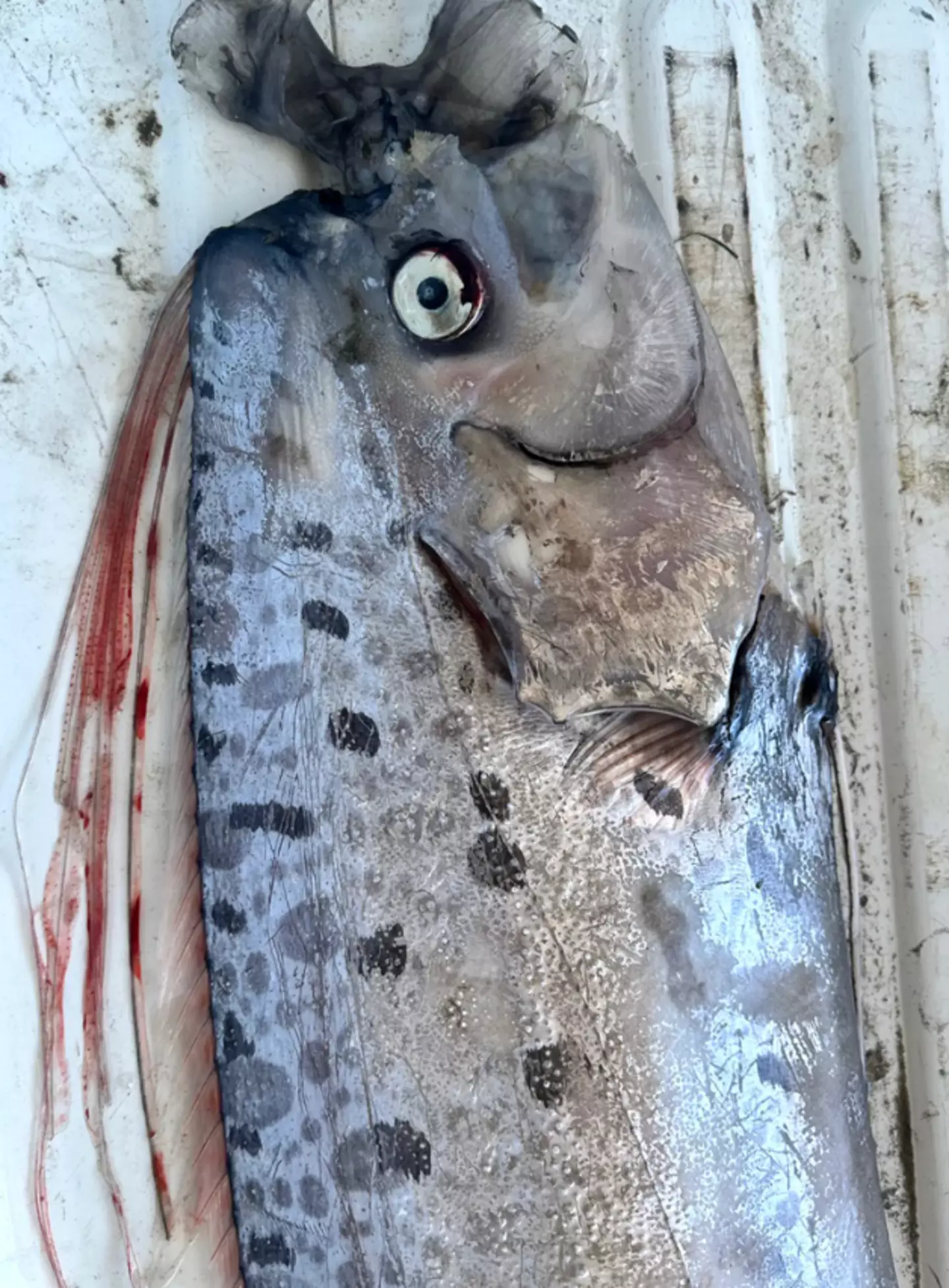
Absolutely no thanks. (Scripps Institution of Oceanography/Facebook)
The Ocean Conservatory describes oarfish as ‘strikingly large, odd-looking fish’. Well, how flattering.
The creatures can also grow to be a huge 30 feet long and have long, silvery and ribbon-shaped bodies.
Oh, and adding to the creepiness, oarfish have creepy looking big eyes and ‘foreboding red spines that stick out to form a crown-like cluster’.
Ben Frable, manager of the Marine Vertebrate Collection explained: “People have studied them, but we’ve very rarely interacted with them alive in their natural habitat.”
“It’s always been a fish of interest, this long, beautiful silver fish,” he added. “It definitely looks fanciful; it evokes the sea serpent mythology.”
Tell you what, if one washed up near me, I don’t think I’d be hanging round for photos with the ‘doomsday fish’.
How’s that for a bad omen?
Man horrified after discovering ‘vampire’ creature washed up on UK beach
As it turns out that the monstrous creatures are showing up on the beaches of Britain now.
Will Miles, 26, found a bizarre looking beast while walking along the beach near Exmouth Marina in Devon.
He explained: “It was very noticeable, lying in the centre part of the beach near the tideline – I was on a walk after work.
“It was like a hugely oversized leech with a sucker full of sharp, inward-pointing teeth.”
So, what is the creature?
.jpg)
Pen News
It’s is a sea lamprey – a species known for sucking the blood of their prey; hence why it’s landed itself with the ‘vampire fish’ nickname.
Once widespread in the UK, they’re now rare, with their decline blamed on low water quality and man-made barriers in the rivers where they breed.
Will, a warehouse worker from Bovey Tracey, estimated the one he came across was about 80cm long – just short of the height of an average two-year-old.
“I was very surprised,” the 26-year-old said.
“I’d never seen one washed up before and expected I never would.”
Keen to share his strange discovery, Will posted a photo on a Facebook page for naturalists.
And though some correctly identified the elusive species, many likened the creature to something straight out of the blockbuster Dune films, based on Frank Herbert’s sci-fi novels.
“Looks like the sandworm from Dune,” wrote one person.
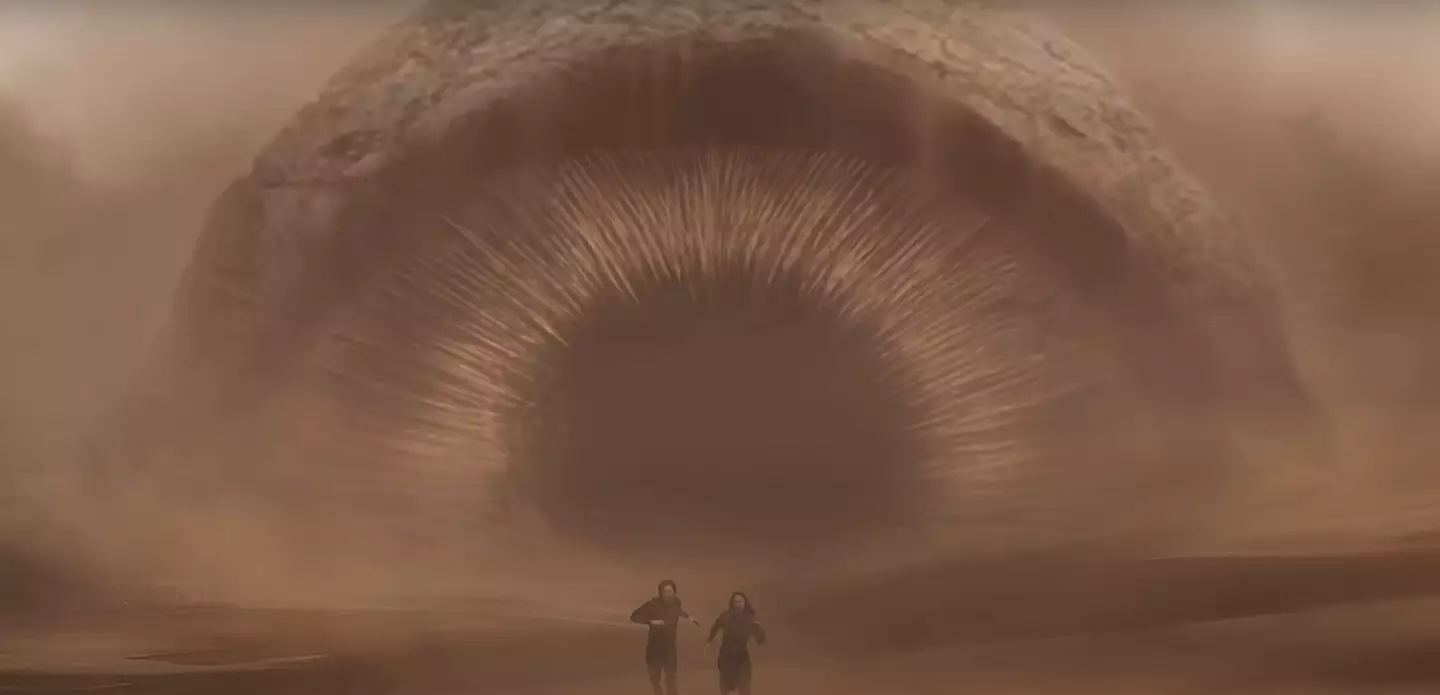
Warner Bros. Pictures
“So that’s where Frank Herbert got his sandworms from,” added another.
“Only just seen the film and that’s where my head went straight away,” replied a third.
Someone else, referring to the fictional world where the series is set, asked: “Is this on Arrakis?”
While others called the creature ‘Shai-Hulud’ – using the name given to the sandworms by the indigenous people of Arrakis, the Fremen.
For others, the creature was more horror than sci-fi.
One comment read: “When I say I love the ocean, I really mean I love the surface. What goes on underneath is terrifying, and none of my business.”
It was enough to make people not want to go back in the water.
“I’m never swimming in the sea again,” said another.
It was also described as a ‘fish of nightmares’ and a ‘terrifying looking creature’.
As gross as that thing looks, it would admittedly be a great way to advertise the Dune franchise.
Just get Zendaya and Timothée Chalamet to do a photoshoot with it, and you’re golden.
Featured Image Credit: PEN News
